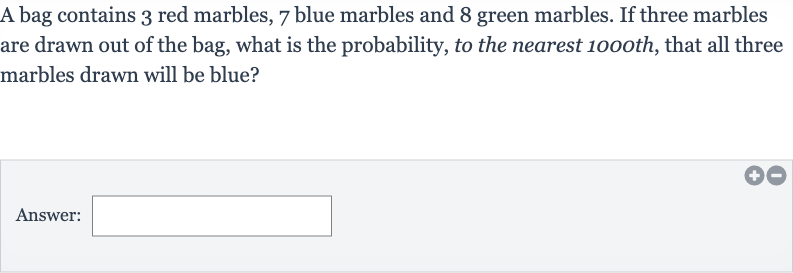AI tutor
Welcome to Bytelearn!
Let’s check out your problem:

A bag contains red marbles, blue marbles and green marbles. If three marbles are drawn out of the bag, what is the probability, to the nearest oooth, that all three marbles drawn will be blue?Answer:
Full solution
Q. A bag contains red marbles, blue marbles and green marbles. If three marbles are drawn out of the bag, what is the probability, to the nearest oooth, that all three marbles drawn will be blue?Answer:
- Calculate Total Marbles: First, we need to determine the total number of marbles in the bag.Total marbles = red + blue + green = marbles.
- Calculate Probability of First Blue Marble: Next, we calculate the probability of drawing one blue marble from the bag.The probability of drawing the first blue marble is the number of blue marbles divided by the total number of marbles.Probability of first blue marble = Number of blue marbles / Total number of marbles = .
- Calculate Probability of Second Blue Marble: After drawing one blue marble, there are now blue marbles left and marbles in total.The probability of drawing a second blue marble is now the number of remaining blue marbles divided by the new total number of marbles.Probability of second blue marble = Number of remaining blue marbles / New total number of marbles = .
- Calculate Probability of Third Blue Marble: After drawing a second blue marble, there are now blue marbles left and marbles in total.The probability of drawing a third blue marble is now the number of remaining blue marbles divided by the new total number of marbles.Probability of third blue marble = Number of remaining blue marbles / New total number of marbles = .
- Calculate Probability of Drawing Three Blue Marbles: To find the probability of all three events happening in sequence (drawing three blue marbles in a row), we multiply the probabilities of each event.Probability of drawing three blue marbles in a row = Probability of first blue marble Probability of second blue marble Probability of third blue marble = .
- Perform Multiplication to Find Probability: Now we perform the multiplication to find the probability.Probability = .
- Simplify Fraction and Round Probability: Finally, we simplify the fraction and round it to the nearest thousandth.Probability (rounded to the nearest thousandth) = (rounded to three decimal places).
More problems from Probability of independent and dependent events
QuestionGet tutor help
QuestionGet tutor help
QuestionGet tutor help
QuestionGet tutor help
QuestionGet tutor help
QuestionGet tutor help
QuestionGet tutor help
QuestionGet tutor help
QuestionGet tutor help
